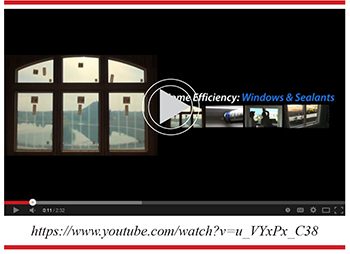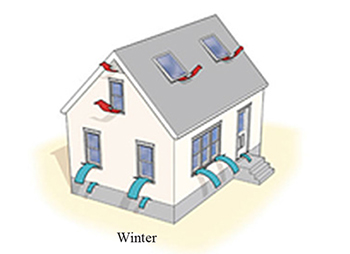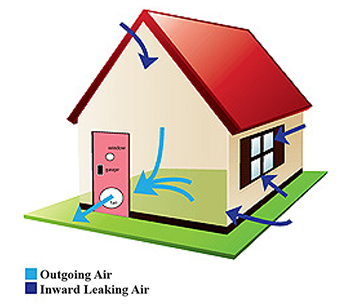G2231
Home Efficiency: Air Sealing
Cracks and gaps around windows, doors, and the foundation of a home waste energy and cost money. Filling unwanted openings with the proper sealant will increase energy efficiency.
F. John Hay, Extension Educator – Energy
Lynn Chamberlin, Nebraska Energy Office
- Blower Door Tests and What They Tell You
- Caulk, Foam, and Weatherstripping: Basic Air-Sealing Materials
- Weatherstripping Options for Doors
- Start at the Top
- Seal and Insulate Ductwork
- Tackle the Low Spots
- Indoor Air Quality
- Air-Sealing Brings Many Benefits
- Resources
 |
|
Big air leaks in homes waste energy and money. Typically these leaks waste between 10 and 25 percent of a home’s heating energy, and the holes and gaps can allow dust, moisture, pollutants, noise, insects, and rodents to enter the home.
To keep heating costs down during cold Nebraska winters, it helps to seal cracks and unwanted openings in your house to prevent drafts that displace precious heat. Warm air will naturally move to a cooler space, so if your house is not well sealed, heat will escape to the cold outdoors. As the warm air escapes, cold outside air is also pulled in through cracks around the foundation and near doors, windows, and other openings to replace heated air being lost.
Since warm air also rises, cracks and openings in the ceiling are a major concern. This air movement pattern is called the stack effect (Figure 1).
Poorly sealed houses act like giant chimneys and the greater the temperature difference between outside and inside, the faster heat moves up and out. Winter winds also speed the process. You can stop this great heat escape by sealing up your house. However, before beginning be sure to correct any moisture or indoor air quality problems in your house, because air-sealing could make them worse. It’s also very important to make sure all combustion appliances such as furnaces and water heaters are working correctly and are properly vented.
Blower Door Tests and What They Tell You
A blower door is a device that depressurizes a home and actually measures the home’s air leakage under pressure. A blower door test reveals whether your home has air leaks and provides an overall tightness measure of your house (Figure 2). It is basically a large fan that pulls air out of your house. As it pulls the air out, the technician can accurately measure air tightness and locate air leaks.
|
You can conduct your own air leak test on a windy day using your hand. Dampen your hand and hold it around closed windows, doors and other suspect places. A slight leak will make your hand feel very cool.
Caulk, Foam, and Weatherstripping: Basic Air-Sealing Materials
How efficiently you are able to seal air leaks depends on the size and location of the leaks and in choosing the right material for the job. Plug larger holes with pieces of drywall or cardboard. Or, stuff the holes with plastic bags, similar to a garbage bag, filled with glass fiber insulation scraps. For most openings, caulking, sealants, and weatherstripping are the most appropriate solutions.
Caulk is a semi-solid, toothpaste-like substance you apply into gaps no wider than 3/8 inch where different building materials meet, such as along a wall and the foundation. Hardware and building supply stores carry many varieties of caulk. Most often, caulking comes in tubes and is applied by using either a caulking gun (Figure 3) or squeezing by hand.
 |
Figure 3. A caulking gun can be used to apply caulk. |
Caulk is also available in card or rope form and applied with your fingers. For sealing cracks and holes in a climate like Nebraska’s, select a quality product that seals well in both cold temperatures and in the heat of summer. Ask a store salesperson for help in choosing the right caulk for the job, and carefully follow the product directions. You’ll need different types of caulk for different surfaces on the inside and outside of your house. Some caulk is waterproof, some not; some can be painted, some not; some expands, some does not. Generally, higher-end caulk seals better, lasts longer, and isn’t much more expensive than the bargain varieties. Air sealing is one area in which you don’t want to scrimp on materials, because a poorly sealed crack is still a crack.
Weatherstripping Options for Doors
Foam sealants are commonly used to fill larger gaps of up to 1 inch. Once applied, they expand to fill and seal the space and, like caulk, they harden as they dry. The two most common types are urethane and latex foam, both of which are available in cans at hardware and building supply stores. Differences between them regarding drying time and cleaning requirements should be taken into consideration when purchasing.
Weatherstripping eliminates gaps between movable parts when they are closed such as around the perimeters of exterior doors and operable windows. Weatherstripping can be made of metal, foam, rubber, vinyl, or felt and is often sold by the foot, or in pre-packaged window/door kits. If possible, always try to match the product that originally came with the door or windows — the finished result will look its best and likely be the most effective. Ask a store salesperson for help in selecting the right product for your job. Some materials are nailed or tacked on, others applied with self-adhesive tape. Well-installed weatherstripping will be slightly compressed when doors and windows are closed.
Start at the Top
Start by sealing gaps between your roof or attic and the living space below. Attention to this area will save the most on your heating bill. Every opening in the ceiling is a potential “chimney” and heat escape route. Check around electrical wires, light fixtures, recessed can lights, chimneys, stove flues, ductwork, plumbing vent pipes, and along the tops of walls.
To walk around in unfinished attics, lay boards on top of the joists, because the ceiling won’t support your weight. Wear a dust mask and gloves in case you have to move or roll insulation back to look for leaks. Dirty spots on your insulation will generally indicate an air leak. In some old homes, partition walls from below open into the attic space. These large openings can be sealed by stuffing them with plastic bags filled with glass fiber insulation. Chimneys and stove flues require special attention. They must be sealed using heat-resistant caulk for small gaps. For larger openings, also add a sheet metal collar to help in sealing. Treat the attic hatch as if it is an outside door and apply weatherstripping around it and add insulation to the attic-side surface.
Seal and Insulate Ductwork
If you have a forced air heating system, it pays to seek out leaks in both the supply and return ducts in attics and crawl spaces. Make sure all the pieces are properly connected. With the furnace fan operating, run your hand over the duct seams/joints to feel for air leaks. Holes in supply ducts will blow air out of the system, and gaps in return ducts will suck air into the system. Plug any leaks you find with foil duct tape (not gray Duct Tape), or better yet, use water-based mastic coupled with glass fiber mesh tape. Once the leaks are fixed, insulate ducts located in unheated areas with foil-faced glass fiber duct insulation. Just wrap the insulation around the duct and secure it into place.
Tackle the Low Spots
Now you’re ready to seal up those places where cold air can get in — around window and door frames and between your living space and unheated basement or crawl space. You can use the same methods and materials as you used in the attic: weatherstrip around doors and operable windows, and seal gaps with caulk, foam, or drywall. Again, make sure to use heat resistant products around chimneys and stove flues. You also can buy inexpensive foam gaskets that fit behind electrical outlet and light switch cover plates. If you have a fireplace, be sure the damper is closed when you’re not using it, and seal it up tighter if you don’t use it much. Be careful down in the basement or crawl space because it is possible to do too much tightening around your home’s foundation. All combustion appliances, such as gas furnaces, water heaters, and ranges, need fresh air to operate properly; too-tight homes may lack adequate air supply for combustion appliances. Lack of combustion air can cause furnaces to produce carbon monoxide and chimneys to backdraft. Contact a heating contractor for assistance in determining just how tightly to seal.
Indoor Air Quality
Air exchange between the home and outdoors is essential for good indoor air quality (Figure 4). This air exchange generally occurs through unintentional air leakage (especially in existing, older homes) or through a mechanical ventilation system. The amount of air leakage into a home can vary based on winds and stack effect, over-ventilating homes during cold windy weather and underventilating them during mild, calm, weather. Contact a heating contractor for assistance in determining whether mechanical ventilation is needed in your home.
 |
Figure 4. Common sources of household indoor air pollutants |
To remove moisture and odors, kitchens and bathrooms should have exhaust fans vented to the outdoors. Clothes dryers should always be vented to the outdoors too, because their exhaust contains moisture, lint, and chemicals from fabrics and soap.
Moisture itself isn’t a pollutant, but excessive moisture encourages mold growth, and mold spores can cause respiratory ailments.
Air-Sealing Brings Many Benefits
No matter who does the work, you or a contractor, the time and money spent on appropriate air-sealing will provide many returns, especially when coupled with attic, wall, and floor insulation. Making your home energy-efficient will not only lower your heating bills, but also keep your home warmer in the winter, cooler in the summer, and cleaner because less dust will blow in. Now that’s an added bonus anyone can appreciate!
Resources
Nebraska Energy Assistance Network: Weatherization
http://www.youtube.com/watch?v=ow7Fsi8IsuQ&list=TL-xm83SCC4y0
More Nebraska Energy Assistance Network Videos
http://www.youtube.com/user/NEANvideo
This publication has been peer reviewed.
Visit the University of Nebraska–Lincoln Extension Publications website for more publications.
Index: Consumer Education
Energy Conservation
Issued April 2014

